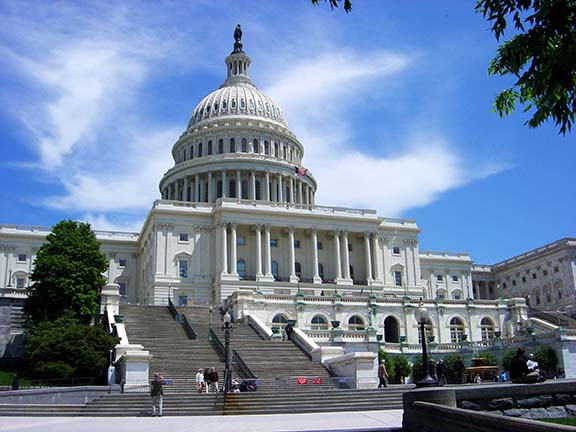On July 27, while most of Washington was focused on the Senate’s healthcare drama, House lawmakers quietly passed their defense appropriation bill and approving in the process a last-minute spending boost for the demonstration of a GPS backup.
On July 27, while most of Washington was focused on the Senate’s healthcare drama, House lawmakers quietly passed their defense appropriation bill and approving in the process a last-minute spending boost for the demonstration of a GPS backup.
The legislation (HR 3219) combined four fiscal year 2018 funding measures: the budgets for the Department of Defense (DoD), military construction/Veterans Affairs, Energy/water and the legislative branch. The package also contained approximately $1.6 billion for the Department of Homeland Security (DHS) to build a physical barrier along the U.S. southern border.
The GPS-related money, a total of $10 million, was added to the Defense budget via an amendment sponsored by Rep. John Garamendi, D-California, and Frank LoBiondo, R-New Jersey. It pays for a directive in the 2018 House authorization bill to devise a demonstration plan for a GPS backup and then actually do the demo.
The Secretaries of Defense, Transportation and Homeland Security are to jointly develop the plan based on the results of a study now underway to determine the requirements for a GPS backup. The requirements study is supposed to be done in December. Officials have 120 days after the enactment of the bill to present their demonstration plan to Congress. But it’s not just about developing a plan; the agencies must perform the demo, wrapping it up 18 months after the bill becomes law.
Lawmakers ordered the work after losing their patience with DoD, Transportation and Homeland Security, which have been squabbling for years over which would take responsibility for building and paying for a backup. In the meantime, the infrastructure that could have supported a nationwide-backup largely has been dismantled.
Enhanced Loran (eLoran) is the system most likely to be chosen at the end of the requirements process, Rep. Garamendi told Inside GNSS, though the demonstration money is technology neutral.
"It’s really going to be for a technology that the secretaries from the Department of Transportation (DoT), Defense and Homeland Security decide is the best way to proceed," Garamendi said. "It is, we believe, likely to be the eLoran system — there being no other real terrestrial-based system available and no other backup that’s readily available, at least any time soon. So it’s likely to be eLoran but (the funding amendment) doesn’t specify that. It does set up a mechanism for them to get on with it and the money to get started with the technical details of how to get it done."
A terrestrially-based backup has some distinct advantages. It is not subject to on-orbit issues like space weather, debris generated by an orbital accident or attack from newly space-capable adversaries. ELoran in particular does not use the same frequencies as GPS and is able to reach receivers in places that GPS cannot, like under water and underground. Autonomous cars driving in a tunnel, Garamendi pointed out, will be able to use eLoran signals.
Given that the accurate timing signals provided by GPS have become essential to a dozen different sectors of critical infrastructure, an independent backup is "very, very important" to U.S. security, the lawmaker said.
"We know that GPS, even the enhanced GPS, is easily corrupted," the congressman said, "and so for defense purposes, for communication purposes, for financial everything, for autonomous cars — you name it — we’ve got to have a backup system."
But why insert the money into the defense appropriations bill as opposed to DoT or DHS?
The Defense Department is as much a customer for a terrestrial backup as any other federal agency and the general public, Garamendi said, and besides — that’s where the money is. "There’s $700 billion reasons," he quipped referring broadly to the DoD’s budget.
Civil Funding?
Though DoD is not the only source of funding for GPS it is the largest and certainly has been the most reliable. DoT has been charged for years with offsetting the cost of certain mostly-civil elements of the GPS program, however Congress consistently has failed to fully fund those obligations. The indications for next year suggest the situation may get worse.
In its budget request for FY17 the Obama administration sought $10 million for civil signal monitoring and got $5.6 million. There was also a request for $1.61 million to support the position, navigation and timing (PNT) activities in the Office of the Assistant Secretary for Research & Technology. Though it was not clear how the cuts in the parent account for the assistant secretary’s office were ultimately distributed, both the House and Senate agreed to the request before they went into conference committee.
This year, at least so far, lawmakers have allocated no money for either activity.
The White House Budget includes $8,465,109 for the Office of the Assistant Secretary for Research & Technology, which includes $2,618,000 that "shall be available through September 30, 2020.” That request is down $4,534,891 from what was enacted for FY17, according to the report accompanying the House bill. That is a drop of 35 percent.
Within that, the budget notes, the White House estimated an obligation of $2 million for PNT in FY18.
The Senate Committee on Transportation, Housing and Urban Development recommended fully funding the Administration’s request, though the report accompanying the bill recommended zeroing out money for both the PNT activities and the civil monitoring. The House Committee supported full funding of the White House’s request but did not weigh in on how it should be distributed.
Both committees did choose, however, to boost funding for the Wide Area Augmentation System (WAAS). The House added $3 million to the White House request for $102.3 million while the Senate added $8 million.
The committees acted out of concern that the current host satellites are nearing retirement age and another year delay in development of WAAS GEO 7 could lead to lost opportunities with host satellites and even a break in service.





